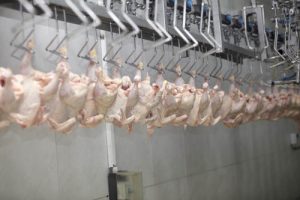Georgia Institute of Technology researchers believe they’re on the edge of a breakthrough, but they don’t want to count their chickens before they are, well, processed.
In Carrollton, Georgia, at Gold Kist’s poultry processing plant, a machine vision system that was developed by GTRI is undergoing field testing. Researchers are hopeful that the results meet their expectations, as it could open the door for automating many visual-inspection tasks in the industry.
Installed at the front of the chicken-processing line, this particular technology is called a systemic screener. The cameras are looking for defects such as improperly bled birds, and those afflicted by systemic diseases, such as septicemia or toxemia.
Unique software and algorithms provide the intelligence for translating visual data from the system’s cameras into the appropriate mechanical commands for dispensation of each chicken. Those that pass the screening proceed to the next step, while unfit chickens are quickly and automatically removed from the processing line.
“It’s a vision-based, closed-loop inspection and removal system — one of the first of its kind,” said Craig Wyvill, chief of the Food Processing Technology Division in the Electro-Optics, Environment and Materials Laboratory of GTRI.
As this technology grows, you can be assured that at UKA we will work with your development team to bring you the most precise lens for your clients’ automation systems as possible. We pride ourselves on the fact that our production, from design all the way through the final manufacturing of the lens is done in-house. This not only assures the highest quality, but also can reduce turnaround time.
By removing unacceptable birds early in the operation, the systemic screener allows subsequent areas of the plant to have “higher utilization of the processing line,” he noted.
While poultry processing is already highly automated, it still depends heavily on manual processes, many of which are visually based. Thus the field trial at Gold Kist is part of a broader effort.
Areas already using technology in the poultry industry are incubators and hatcheries, feed mills, laying hens equipment, poultry breeding equipment and other areas that automation has been in place for a few years, but, could still benefit from the research being developed at GTRI.
“We’re looking at applications that span the whole gamut of the processing operation,” said Wayne Daley, senior research engineer at GTRI and head of the development team. “From beginning to end, live bird to the shrink-wrapped package, there are places where visual input is required to properly process the product. We’re looking at where we can apply machine vision technology, what would be required, and how we can modify our system to run tests and see how it functions.”
GTRI’s work with poultry is attracting attention from other segments of the food industry, as well. Representatives from the citrus and bakery industries are already working with Tech on machine vision techniques for high-speed imaging of products for quality evaluation and control of processes, Wyvill said.
“We think there’s a huge potential for computer imaging as an automatic quality evaluation and control system through the whole food industry,” he added.
With that in mind, the possibilities for your client to fully-automate their operations could potentially be endless.
Universe Kogaku designs and manufactures optical lenses for poultry inspection and automation, security, high tech and electronic applications. We stock 1000’s of standard lens assemblies and can custom design a solution for scanners, CCTV, CCD/CMOS, medical imaging, surveillance systems, machine vision and night vision systems.